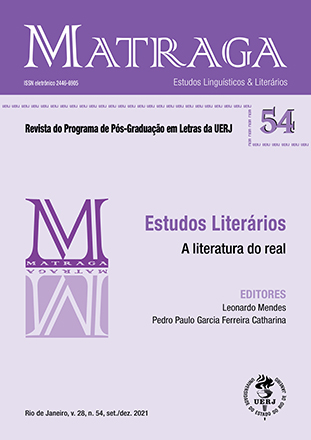Balzac entre realismos: uma leitura de A obra-prima ignorada (1831) à luz de Rancière
DOI:
https://doi.org/10.12957/matraga.2021.58759Palavras-chave:
Realismo, Revolução estética, Balzac, Partilha do sensível, Literatura moderna.Resumo
O artigo visa propor alguns pontos de referência para compreender a singularidade do realismo como parte integrante da literatura moderna e desatrelado do dito imperativo de representação do real – tão criticado por vanguardas e teorias do século XX. Para tanto, partimos de uma contraposição entre, de um lado, a leitura auerbachiana de Stendhal e, de outro, do que a lógica antiga do decoro previa como os possíveis da representação literária – a observância de sedes argumentativas que, mesmo onde os gêneros se misturam, mantém intacta uma ordem do discurso que guarda forte analogia com uma partilha de lugares sociais. Contra esse fundo, o novo que emerge no discurso realista aparece como o que Rancière (2009a) denomina “revolução estética”: uma implosão da lógica hierárquica da representação em nome de um regime em que o real adentra o relato literário sem o apoio de sedes previstas. A desierarquização posta em jogo pelo regime estético é uma glória do qualquer, segundo a qual não só o os homens mais infames (FOUCAULT, 1998) podem sentir e falar como os reis da tragédia, como também o detalhe mais anódino pode guardar em si a significação da obra. A partir disso, propomos uma análise da novela A obra-prima ignorada (1831), de Balzac, enquanto figuração privilegiada tanto dos riscos e excessos possíveis das vanguardas por vir, como da vida infame que visa representar o relato realista.
Downloads
Downloads
Publicado
Como Citar
Edição
Seção
Licença
AUTORIZAÇÃO
A Matraga – Revista do Programa de Pós-Graduação em Letras da UERJ está autorizada a publicar o artigo ora submetido, caso seja aceito para publicação online. Fica atestado que a contribuição é original, que não está sendo submetida a outro editor para publicação, e que a presente declaração é a expressão da verdade.
Os trabalhos publicados no espaço virtual da Matraga – Revista do Programa de Pós-Graduação em Letras da UERJ serão automaticamente cedidos, ficando os seus direitos autorais reservados à Matraga. Sua reprodução, total ou parcial, é condicionada à citação dos autores e dos dados da publicação.

A Matraga utiliza uma Licença Creative Commons - Atribuição-NãoComercial 4.0 Internacional.





